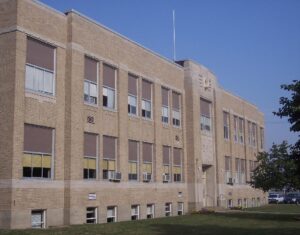
Summary: Following a six-month study commissioned by the school board, consultants from Education Resource Strategies (ERS) unveiled their plan to reshape Pittsburgh Public Schools (PPS). That’s in light of declining enrollment and against the backdrop of continued educational deficiencies and financial challenges. This Brief examines the effects and implications for PPS were the plan to be adopted.
Introduction
As of the 2023 Annual Comprehensive Financial Report (ACFR), PPS had 19,764 students but space (functional capacity) for 16,000 more. Thus, in January the board passed a resolution calling for a facilities utilization plan and issued a request for proposals two months later. On Oct. 15, the consultants delivered their final recommendations for “opening three new schools, reconfiguring 12 schools and closing 14 schools and 10 facilities, which would reduce the District’s footprint from 54 to 42 schools.”
PPS’ footprint currently consists of 60 buildings totaling 6 million square feet. The 10 buildings slated for closure are Schiller; Morrow (primary); Spring Hill; Miller; Montessori; King; Conroy; Fulton; Woolslair and the Student Achievement Center at Baxter. The district’s utilization percentage (enrollment divided by functional capacity) stands at 53 percent as of the latest update. The average utilization factor for the buildings set to close is 51 percent, ranging from 25 percent to 74 percent. ERS noted that building capacity and quality — including age, enrollment, need for renovations, location relative to student needs, etc. — were considered in their school closure recommendations.
Financial impact
As noted in Policy Brief Vol. 23, No. 42, PPS continues to face longstanding financial issues and school closures present an avenue to begin reducing expenditures. ERS projects that implementation would “result in a net change of up to $3 million annually and the potential reduction in capital investment by more than $50 million.” The Montessori and Woolslair facilities need extensive (and costly) renovations to add air conditioning, which would no longer be necessary were they to close.
Typically, building closures would result in downsizing, driving down staffing costs for the district. However, the proposed reconfiguration of grade levels, programs and course offerings would likely lead to staff relocations rather than layoffs. ERS predicts that “student-facing resources (such as teachers, counselors, social workers, etc.) would be generally shifted, not reduced.” Furthermore, due to typical attrition rates, headcount reductions would be expected to remove vacancies rather than filled positions. The 2023 ACFR shows PPS had 3,912 total employees of which 2,232 were instructional. The final impact on staff will revolve around the actions undertaken by the school board.
Pennsylvania law requires that there must be a public hearing three months before any closures. Public backlash resulted in the consultants revising their plan from the initial proposal in August, while a counter-proposal has been drafted by a group of parents, which includes only five school closures. So, while the proposed sale of excess buildings would present a prudent path forward, any plan adopted would need to convince both the public and the school board.
Assuming the ERS closures move forward, there is no guarantee these buildings make their way onto the tax rolls. Any prospective buyer will be asked to detail its plan for the property, involve and consult the public and work with the City Council member where the property is located as per a 2021 amendment to PPS’ policy manual. If a building is sold to a non-profit, other governmental entity or retained by the district it remains tax-exempt. There is $20.3 billion taxable assessed value in the district and another $11.6 billion that is tax-exempt. The 10 buildings slated for closure total $50.1 million in assessed value. While this is only 0.43 percent of the total exempt property, their sale would nonetheless ease some of the burden on the district’s budget via savings on building maintenance and repair.
Academics & education
PPS currently has five different grade configurations: PreK-5; PreK-8; 6-8; 6-12 and 9-12. The proposed plan would restructure the grade levels to PreK-5, 6-8, and 9-12. In doing so, ERS anticipates better student transitions and experiences, while allowing for improved facilities and more diverse course offerings, opportunities and accessibility programs.
The latest available data (2022-23) show PPS’ current expenditure per student (ADM, average daily membership) was $29,375. The statewide average was $19,141. Past Policy Briefs have noted that, despite cost per pupil ranking among the state’s highest, PPS’ educational attainment metrics have been consistently below the state average.
| 2023 PSSA Scores, Percentage of Students Who Scored Proficient or Above | ||
| Level | Language Arts Average | Math Average |
| Statewide | 53.7% | 39.4% |
| PPS District | 42.0% | 25.6% |
Eight schools whose buildings are set for closure reported 2023 Pennsylvania System of School Assessment (PSSA) scores for math and language arts exams. King, Miller, Spring Hill, and Morrow all fell considerably below the district average on both the math and language arts exams. Schiller and Woolslair were mixed. Fulton and Montessori surpassed the district average. Morrow is set to reopen as a PreK-5 school at its intermediate building while Montessori PreK-5 will relocate to the Linden facility.
Conclusion
A preview of the preliminary budget for 2025 reveals that PPS is planning for $739 million in expenditures, a 3.1 percent increase from 2024. This budget assumes no school changes. The Allegheny Institute has long pointed out that PPS spends an unconscionable amount per pupil and reductions in expenditures are desperately needed. School closures could present potential savings on staff and maintenance costs, while selling the land/buildings to the private sector places them on the tax rolls. In doing so, PPS also has the opportunity to focus its resources on providing a better educational experience for students. The decision over whether the ERS plan is the best way to move forward now rests with the school board.
